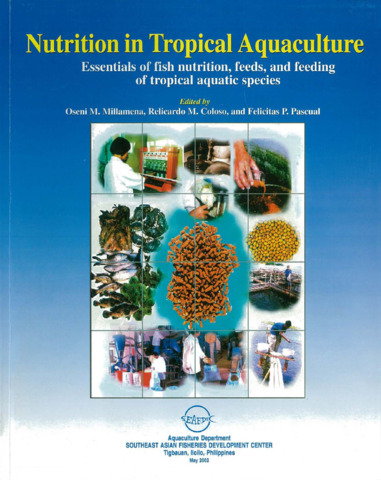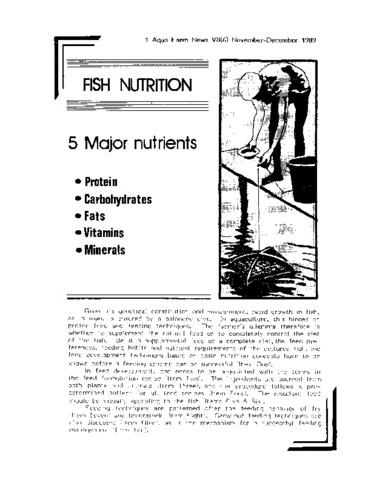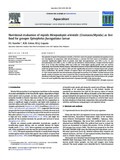Nutrition in tropical aquaculture: Essentials of fish nutrition, feeds, and feeding of tropical aquatic species
- Global styles
- MLA
- Vancouver
- Elsevier - Harvard
- APA
- Help
Share
Abstract
This book is intended to teach undergraduate students the essentials of aquaculture nutrition, feed formulation, and feeding management. It serves as a reference book for researchers in aquaculture, aquaculturists, fish farmers, and aquaculture nutritionists. For the basic understanding of the materials presented, it is essential that the students, teachers, and researchers have a good background in chemistry, fish biology, or fisheries. The book covers the subject areas of known nutrient requirements, effects of nutrient deficiencies on various aquatic species, nutrient sources, digestibility, and digestive physiology. Feed formulation, processing and storage, evaluation and quality control, feeding management, as well as the economics of feeding are included. Aspects on feeds and feeding related to the conservation of the aquatic environment are also dealt with.
Each chapter of this book has common features such as an introduction, basic concepts, and a summary. Both the basic and practical aspects of fish nutrition are included to give the students and allow the readers who are unfamiliar with the topics a clear understanding and knowledge of these concepts. Study questions at the end of each chapter serve as a guide to summarize and impress on the students the salient points of the subject matter in each chapter. To easily comprehend the subject matter, there is an appendix containing the analytical methods and a glossary of technical terms. The users particularly the students are encouraged to broaden their knowledge by referring to the list of references and suggested readings at the end of each chapter.
Suggested Citation
Millamena, O. M., Coloso, R. M., & Pascual, F. P. (Eds.). (2002). Nutrition in tropical aquaculture: Essentials of fish nutrition, feeds, and feeding of tropical aquatic species. Tigbauan, Iloilo, Philippines: Aquaculture Department, Southeast Asian Fisheries Development Center.
Contents
- Foreword
- About the authors and editors
- Preface
- Chapter 1
INTRODUCTION TO NUTRITION IN TROPICAL AQUACULTURE
Oseni M. Millamena- Feeds in aquaculture
- Feeds and the environment
- Sustainable approaches to aquaculture
- Summary
- Suggested readings
- Chapter 2
THE ESSENTIAL NUTRIENTS
Oseni M. Millamena- Proteins and amino acids
- Introduction
- Amino acids
- Classification of amino acids
- Essential amino acids
- Non-essential amino acids
- Classification of proteins
- Protein structure
- Fate of absorbed amino acids
- Importance of amino acid profiles in fish nutrition
- Qualitative amino acid requirements
- Quantitative amino acid requirements
- Deficiencies and excesses of dietary amino acids
- Evaluation of protein quality
- Protein requirement
- Guide questions
- Lipids and fatty acids
- Introduction
- Types of lipids
- General function of lipids
- Fatty acids
- Structure and classification
- Nomenclature
- Fatty acid composition of fish
- Biosynthesis of fatty acids
- Oxidation of fatty acids
- Lipid peroxidation
- Importance of fatty acid profiles in fish nutrition
- Essential Fatty Acid Requirements of Fish
- Guide questions
- Carbohydrates
- Introduction
- Classification of carbohydrates
- Monosaccharides
- Disaccharides and oligosaccharides
- Polysaccharides
- Utilization of carbohydrates
- Guide questions
- Energy
- Introduction
- Utilization of energy
- Energy metabolism
- Energy balance and dietary requirement
- Dietary energy requirement
- Guide questions
- Vitamins
- Introduction
- Classification of vitamins
- Water-soluble vitamins
- Lipid-soluble vitamins
- Vitamin requirements of fish
- Guide questions
- Minerals
- Introduction
- Classification of minerals
- General functions of minerals
- Mineral availability
- Macrominerals
- Microminerals
- Mineral supplementation of practical fish diets
- Mineral requirements of fish
- Guide questions
- Summary
- Suggested readings
- Proteins and amino acids
- Chapter 3
FEEDING HABITS AND DIGESTIVE PHYSIOLOGY OF FISHES
Ilda G. Borlongan, Relicardo M. Coloso and Nelson V. Golez- Introduction
- Feeding habits and behavior
- Anatomy and physiology of the digestive system
- Fishes
- Crustaceans
- Digestion and absorption
- Digestion and absorption of proteins
- Digestion and absorption of carbohydrates
- Digestion and absorption of lipids
- Measurements and analysis used in digestion studies
- Measurements of stomach contents
- Measurement of digestibility
- Factors affecting digestion and absorption
- Feeding process in fish
- Appetite and satiation
- Arousal and search
- Location and identification
- Capture
- Taste testing
- Swallowing or rejection
- Summary
- Guide questions
- Suggested readings
- Chapter 4
FORMULATION OF AQUAFEEDS
Mae R. Catacutan- Introduction
- Feed ingredients for aquaculture
- Feed formulation
- Pearson’s square and algebraic equation methods
- Trial and error method
- Linear program for least cost formulation
- Purified diet formulation
- Summary
- Guide questions
- Suggested readings
- Chapter 5
PROCESSING OF FEEDSTUFFS AND AQUAFEEDS
Nelson V. Golez- Introduction
- Feedstuff processing
- Different methods of feedstuff processing
- Soaking
- Heating and cooking
- Dehulling
- Extraction with organic solvent and chemical treatment
- Feed preparation techniques
- Grinding
- Size grading or sieving
- Weighing
- Mixing
- Conditioning
- Pelleting and extrusion
- Pellet cooling and drying
- Pellet crumbler
- Pellet and crumbled feed cleaner
- Product packaging and storage
- Steps in large-scale feed preparation
- Steps in small-scale feed preparation
- Steps in larval feed preparation
- Quality control
- Feed mill sanitation and maintenance
- Summary
- Guide questions
- Suggested readings
- Chapter 6
EVALUATION OF FEEDSTUFFS AND AQUAFEEDS
Myrna B. Teruel- Introduction
- Physical evaluation
- Use of the senses
- Feed microscopy
- Measurements of feedstuffs bulk density
- Attractability
- Water stability
- Chemical evaluation
- Proximate analysis
- Methods of protein evaluation
- Methods of lipid evaluation
- Method of vitamin evaluation
- Methods of mineral evaluation
- Methods of energy determination
- Analysis of toxins in feeds
- Microbiological evaluation
- Biological evaluation
- Parameters to be monitored in a feeding experiment
- Summary
- Guide questions
- Suggested readings
- Chapter 7
MANAGEMENT OF FEEDING AQUACULTURE SPECIES
Veronica R. Alava- Introduction
- Feeding strategies in pond culture
- Production of natural aquatic food
- Feeding a supplementary diet
- Feeding a complete diet
- Feeding management
- Sampling and record keeping
- Feeding ration
- Feed particle size
- Feed application methods
- Feeding, water quality, and the environment
- Feeding, oxygen requirements, and water quality
- Fish farm wastes
- Performance measures
- Biomass
- Feed conversion ratio
- Feeding schemes
- Milkfish
- Tilapias
- Rabbitfish
- Bighead carp
- Native catfish
- Asian sea bass
- Orange-spotted grouper
- Mangrove red snapper
- Tiger shrimp
- Mud crabs
- Other species for Stock enhancement
- Donkey’s ear abalone
- Seahorses
- Window pane oyster
- Summary
- Guide questions
- Suggested readings
- Chapter 8
ECONOMICS OF FEEDING
Renato F. Agbayani- Introduction
- Cost of producing feeds
- Single input and single output production function
- The production function and the cost of production
- Economic efficiency of feeds
- Least-cost combination of feeds
- Minimum cost of feed formulation using linear programming
- Summary
- Guide questions
- Suggested readings
- APPENDIX
- Sample worksheet for calculating the nutrient composition of feed
- Methods of protein analysis (Kjeldahl Method)
- Crude fat analysis (Soxhtec Method)
- Lipid extraction (Bligh and Dyer Method)
- Saponification and transesterification
- Method of peroxide value determination
- Procedure of fatty acid value determination
- Thiobarbituric acid (TBA) value determination
- GLOSSARY
- ILLUSTRATION AND PHOTO CREDITS
- INDEX
Type
BookISBN
971851158XFormat
xx, 221, [20] p. : col. ill. ; 28 cm
Related items
Showing items related by title, author, creator and subject.
-
Fish nutrition
Carreon-Lagoc, Julia; Southeast Asian Fisheries Development Center, Aquaculture Department (Aquaculture Department, Southeast Asian Fisheries Development Center, 1989) -
Nutritional evaluation of mysids Mesopodopsis orientalis (Crustacea:Mysida) as live food for grouper Epinephelus fuscoguttatus larvae
Eusebio, P. S.; Coloso, R. M.; Gapasin, R. S. J. (Elsevier, 2010)The potential of mysids Mesopodopsis orientalis as live food source for grouper Epinephelus fuscoguttatus larvae was investigated. In comparison with Artemia biomass, a common live food source in larviculture, mysids ... -
A practical broodstock diet for the mangrove red snapper, Lutjanus argentimaculatus
Emata, Arnil C.; Borlongan, Ilda G. (Elsevier, 2003)A practical broodstock diet (39% protein, 8.6% lipid) was formulated for the mangrove red snapper as part of a project to ensure consistent production of good quality eggs and larvae through broodstock nutrition. Reproductive ...






